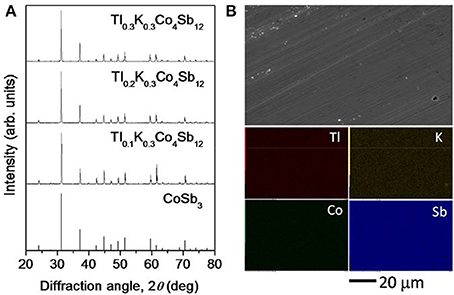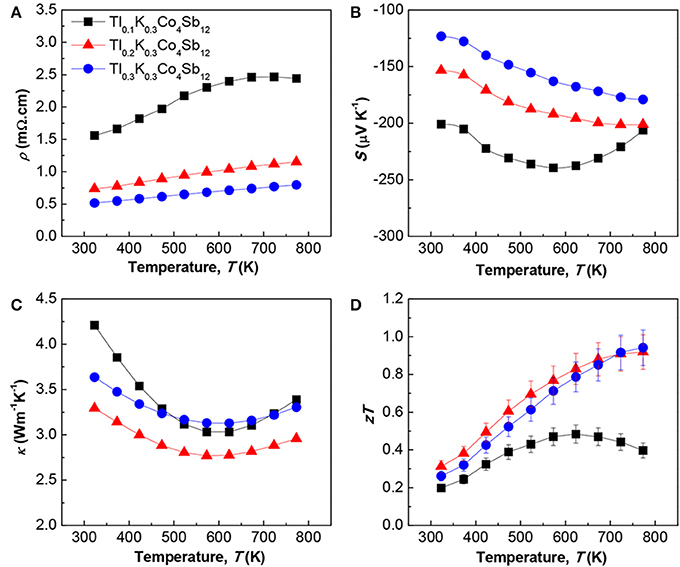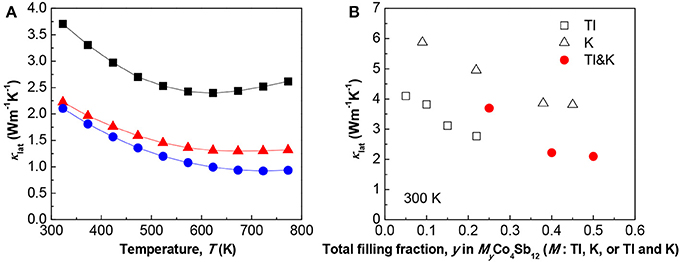Enhancement of thermoelectric efficiency of CoSb3-based skutterudites by double filling with K and Tl
- 1Division of Sustainable Energy and Environmental Engineering, Graduate School of Engineering, Osaka University, Suita, Japan
- 2Research Institute of Nuclear Engineering, University of Fukui, Tsuruga, Japan
The high-temperature thermoelectric properties of thallium (Tl) and potassium (K) double-filled cobalt antimonide (CoSb3)-based skutterudites with nominal compositions TlxK0.3Co4Sb12 (x = 0.1 − 0.3) were investigated. The filling fraction of Tl in CoSb3 was enhanced by co-filling with K, which resulted in all of the samples showing the filled-skutterudite single phase. Owing to the high filling ratio, the carrier concentration in the sample with x = 0.3 was as high as 4.3 × 1020 cm−3 at room temperature. Furthermore, quite low lattice thermal conductivity (as low as 0.9 Wm−1K−1) was obtained for the sample with x = 0.3, probably because of strong phonon scattering by the Tl and K co-rattling effect, which resulted in a maximum zT of around one at 773 K.
Introduction
Thermoelectric (TE) materials can be used for direct energy conversion from waste heat into electrical power, and have advantages of no moving parts and high reliability. The efficiency of the energy conversion of TE materials is governed by the material's dimensionless figure of merit: zT = S2T/ρκ, where S is the Seebeck coefficient, T is the absolute temperature, ρ is the electrical resistivity, and κ is the total thermal conductivity (κ = κlat +κel, where κlat and κel are the lattice and electronic contributions, respectively (Ioffe, 1957; Slack, 1995; Nolas et al., 2001). Because the zT value directly reflects the energy conversion efficiency, development of high-zT materials is important for effective energy saving by recycling the waste heat by TE technology. It is considered that materials with zT > 1 should be obtained for practical application. To achieve such a high zT, a large S, low ρ, and low κ are required. However, S, ρ, and κel are strongly interrelated with each other in materials, therefore reduction of κlat is required to maximize zT (Ioffe, 1957; Nolas et al., 2001).
Skutterudite compounds have the composition MX3, where M is a transition metal, such as Co, and X represents a pnicogen atom, such as Sb. These compounds are body-centered cubic with 32 atoms in the unit cell and the space group Im3. The structure contains two voids per unit cell. When a third atom A is incorporated into the voids, the formula of the compounds, referred to as filled skutterudites, becomes AM4X12. The A atom is weakly bonded to the other atoms and “rattles,” leading to strong scattering of heat-carrying phonons. Thus, the introduction of A atoms into the voids of the skutterudite structure is an effective method for reducing κlat. Although skutterudites filled with alkali, alkaline-earth, or rare-earth metals with zT > 1 have been widely reported (Morelli et al., 1997; Nolas et al., 2000; Chen et al., 2001; Lamberton et al., 2002; Puyet et al., 2004; Pei et al., 2006; Zhao et al., 2006), skutterudites filled with other elements, such as group 13 elements such as thallium (Tl), have been scarcely reported (Harnwunggmoung et al., 2010; Qiu et al., 2013; Tang et al., 2014). Recently, the vibrational frequencies of the filler atoms in cobalt antimonide (CoSb3)-based skutterudites have been calculated by density functional theory. It was found that the vibrational frequencies were significantly different for different chemical groups of the periodic table (Yang et al., 2007). It has been suggested that only the lattice phonons with frequencies near the vibrational frequency of the fillers can be strongly scattered via phonon resonant scattering (Shi et al., 2008). Thus, introducing filler elements belonging to different chemical groups into the cages of CoSb3 could introduce various distinctive filler vibrational frequencies for a broader range of lattice phonon scattering, leading to further κlat reduction (Shi et al., 2011). In the present study, we selected Tl (one of the heaviest elements) and potassium (K) (one of the lightest elements) as the double-filling combination to achieve significant reduction of κlat of CoSb3-based skutterudites. Based on previous studies (Pei et al., 2006; Harnwunggmoung et al., 2010) we selected the sample compositions TlxK0.3Co4Sb12 (x = 0.1 − 0.3) and their high-temperature TE properties were investigated. The effect of Tl and K double-filling on the TE properties of CoSb3 was also investigated.
Experimental
Polycrystalline samples of Tl and K double-filled skutterudites, TlxK0.3Co4Sb12 (x = 0.1 − 0.3), were synthesized by a combination of melting, quenching, and long-term high-temperature annealing. The high-purity elements Tl (99.9%), K (99%), Co (99.99%), and Sb (99.999%) were weighed in appropriate ratios then placed in a carbon crucible in a silica tube. Considering that K rapidly evaporates at high temperatures, appropriate amounts of excess K were added to the mixtures of the starting materials. The silica tubes were sealed under vacuum, heated slowly up to 1323 K, and then quenched to room temperature. The silica tubes were then heated again up to 873 K and annealed for 1 week. The obtained ingots were crushed into powders, followed by spark plasma sintering at 923 K under a pressure of 50 MPa for 15 min in an Ar flow atmosphere.
Structural characterization was conducted using X-ray diffraction (XRD) analysis in air at room temperature with Cu Kα radiation. The microstructure and chemical composition of the samples were investigated by field emission scanning electron microscopy (FE-SEM) with energy dispersive X-ray (EDX) analysis in vacuum at room temperature. S and ρ were measured using a commercially-available apparatus (ULVAC, ZEM-1) in a He atmosphere. The thermal diffusivity (α) was measured by the laser flash method in a vacuum using a commercially available, thermal constant analyzer (ULVAC TC-7000). κ was evaluated via the standard equation of κ = αCpd, where Cp and d are the heat capacity and density, respectively. Cp was estimated using the Dulong–Petit model: Cp = 3nR, where n is the number of atoms per formula unit and R is the gas constant. All of the TE properties were measured from room temperature to 773 K.
The Hall coefficient (RH) was measured at room temperature by the van der Pauw method under vacuum with an applied magnetic field of 0.5 T. The Hall carrier concentration (nH) and Hall mobility (μH) were calculated from RH assuming a single band model and a Hall factor of 1, i.e., nH = 1/(eRH) and μH = RH/ρ, where e is the elementary electric charge. The density of the bulk samples was calculated based on the samples' weight and dimensions.
Results and Discussion
The powder XRD patterns of the polycrystalline samples of TlxK0.3Co4Sb12 (x = 0.1 − 0.3) are shown in Figure 1A, together with the peak positions of CoSb3. All of the peaks in the XRD patterns were identified as peaks derived from the skutterudite phase. The lattice parameters (a) of the samples calculated from the XRD patterns almost linearly increased with increasing Tl content, as summarized in Table 1. The densities of the samples are summarized in Table 1. All of the samples had high densities equivalent to approximately 98% of the theoretical densities. The FE-SEM and EDX mapping images of the sample with x = 0.3 are shown in Figure 1B. The FE-SEM image confirmed that the sample was homogeneous. EDX analysis revealed that Tl, K, Co, and Sb were uniformly distributed on the sample surface. The chemical compositions of all of the samples determined by the quantitative EDX analysis are summarized in Table 1. The K contents in the EDX compositions were clearly lower than in the nominal compositions, probably because of the volatilization loss of K during the synthesis. The XRD and FE-SEM/EDX results revealed that all of the Tl and K added to CoSb3 filled the voids of the skutterudite structure, and thus all of the samples prepared in the present study were skutterudite single phases with no impurity phases.

Figure 1. (A) Powder XRD patterns of polycrystalline samples of TlxK0.3Co4Sb12 (x = 0.1 − 0.3), together with the peak positions of CoSb3. (B) FE-SEM and EDX mapping images of the Tl0.3K0.3Co4Sb12 bulk sample.

Table 1. Nominal and EDX compositions, lattice parameter (a), carrier concentration (nH), carrier mobility (μH), and density (d) of the samples.
The room temperature values of nH and μH for the samples are summarized in Table 1. It was confirmed that increasing the Tl content increased nH. Owing to the large amounts of the filler elements Tl and K, very high nH values (e.g., 4.3 × 1020 cm−3 for the sample with x = 0.3) were obtained. The μH of the samples slightly decreased with increasing nH, mainly because of the increase of carrier–carrier scattering.
The temperature dependences of ρ, S, κ, and zT are shown in Figures 2A–D, respectively. As shown in Figure 2A, ρ increased with increasing temperature, showing the typical heavily-doped semiconductor behavior reported by Mallik et al. (2008). As summarized in Table 1, nH greatly increased while μH slightly decreased with increasing Tl content, leading to a decrease in ρ with increasing Tl content. S was negative for all of the samples, as shown in Figure 2B, indicating that the majority of charge carriers were electrons. The absolute values of S decreased with increasing Tl content. The results for both ρ and S can be explained by nH increasing by adding Tl. As shown in Figure 2C, all of the samples showed very low κ values. The sample with x = 0.3 showed higher κ than the sample with x = 0.2 because of the large κel of the sample with x = 0.3. Owing to sufficiently reduced κ, all of the samples exhibited relatively high zT values, as shown in Figure 2D. The maximum zT of around one was obtained at 773 K for the nominal compositions Tl0.2K0.3Co4Sb12 and Tl0.3K0.3Co4Sb12.

Figure 2. Temperature dependences of (A) electrical resistivity ρ, (B) Seebeck coefficient S, (C) thermal conductivity κ, and (D) dimensionless figure of merit zT of polycrystalline bulk samples of TlxK0.3Co4Sb12 (x = 0.1 − 0.3).
Figure 3A shows the temperature dependence of κlat for TlxK0.3Co4Sb12 (x = 0.1 − 0.3), which was obtained by subtracting the κel value from the total (measured) κ value. The value of κel can be calculated using κel = LσT, where σ is the electrical comductivity and L is the Lorenz number (= 2.45 × 10−8 W Ω K−2). The sample with x = 0.3 had the lowest κlat in the entire temperature range. Furthermore, the bipolar effect, which is observed as a rapid increase in the κlat value at high temperatures, can be seen in the sample with x = 0.1. It is considered that the large nH in the samples of x = 0.2 and 0.3 effectively depresses the bipolar effect at high temperatures. The bipolar effect is also observed in the temperature dependence of S in Figure 2B, i.e., the S of the sample with x = 0.1 first decreases with temperature and then increases with temperature above about 600 K. A κlat value as low as 0.9 Wm−1 K−1 was obtained for the sample with x = 0.3. The κlat values obtained in the present study are relatively low compared with those of other reported filled-skutterudite compounds. These results indicate that Tl and K double-filling is an effective way to scatter heat-carrying phonons and thus achieve sufficiently low κlat.

Figure 3. (A) Temperature dependence of the lattice thermal conductivity κlat of polycrystalline bulk samples of TlxK0.3Co4Sb12 (x = 0.1 − 0.3). (B) κlat at 300 K vs. the total filling fraction y in MyCo4Sb12 (M = Tl, K, or Tl and K). The data for Tl- and K-filled skutterudites were obtained from Harnwunggmoung et al. (2010) and Pei et al. (2006), respectively.
Figure 3B shows the κlat value at 300 K vs. the total filling fraction y in MyCo4Sb12 (M = Tl, K, or Tl and K). Note that, here, the filling fraction of the Tl and K double-filling system, i.e., the y values in (Tl, K)yCo4Sb12, were calculated based on the EDX compositions. In the case of the single element-filled system, it has been reported that the maximum filling limit y is around 0.2 (Harnwunggmoung et al., 2010) and 0.45 (Pei et al., 2006) for TlyCo4Sb12 and KyCo4Sb12, respectively. However, in the case of the Tl and K double-filling system, the total filling fraction was as high as 50% in the voids of the skutterudite structure, in other words, y = 0.5 in (Tl, K)yCo4Sb12. This large filling fraction led to significantly reduced κlat, and thus very high zT values around one were obtained.
Summary
In the present study, polycrystalline samples of Tl and K double-filled skutterudites with nominal compositions TlxK0.3Co4Sb12 (x = 0.1 − 0.3) were prepared and their high-temperature TE properties were investigated. This is the first attempt to co-fill group 13 elements and alkaline metals into CoSb3-based skutterudites. All of the samples showed the skutterudite single phase, although the maximum filling limits in the single-filled systems were y = 0.2 and 0.45 for TlyCo4Sb12 and KyCo4Sb12, respectively. Owing to the large filling fraction of Tl and K, high nH (~4.3 × 1020 cm−3) and low κlat (~0.9 W m−1 K−1) values were obtained. It can be concluded that Tl and K double-filling increases the maximum filling limit, and thus it is an effective way to reduce the κlat value of CoSb3. The maximum zT of around one was obtained at 773 K for the samples with nominal compositions Tl0.3K0.3Co4Sb12 and Tl0.2K0.3Co4Sb12.
Conflict of Interest Statement
The authors declare that the research was conducted in the absence of any commercial or financial relationships that could be construed as a potential conflict of interest.
Acknowledgments
This work was supported by a Grant-in-Aid for Scientific Research (No. 25289220) from the Ministry of Education, Culture, Sports, Science and Technology of Japan.
References
Chen, L. D., Kawahara, T., Tang, X. F., Goto, T., Hirai, T., Dyck, J. S., et al. (2001). Anomalous barium filling fraction and n-type thermoelectric performance of BayCo4Sb12. J. Appl. Phys. 90, 1864–1868. doi: 10.1063/1.1388162
Harnwunggmoung, A., Kurosaki, K., Muta, H., and Yamanaka, S. (2010). High-temperature thermoelectric properties of thallium-filled skutterudites. Appl. Phys. Lett. 96, 202107. doi: 10.1063/1.3430739
Pubmed Abstract | Pubmed Full Text | CrossRef Full Text | Google Scholar
Ioffe, A. F. (1957). Semiconductor Thermoelements and Thermoelectric Cooling. London: Infosearch Limited.
Lamberton, G. A. Jr., Bhattacharya, S., Littleton, R. T. IV., Kaeser, M. A., Tedstrom, R. H., Tritt, T. M., et al. (2002). High figure of merit in Eu-filled CoSb3-based skutterudites. Appl. Phys. Lett. 80, 598–600. doi: 10.1063/1.1433911
Mallik, R. C., Stiewe, C., Karpinski, G., Hassdorf, R., and Müller, E. (2008). “Thermoelectric properties of CoSb3 and In0.5CoSb3 skutterudite materials,” in Proceedings of the 6th European Conference on Thermoelectrics (ECT) (Paris).
Morelli, D. T., Meisner, G. P., Chen, B., Hu, S., and Uher, C. (1997). Cerium filling and doping of cobalt triantimonide. Phys. Rev. B 56, 7376–7383. doi: 10.1103/PhysRevB.56.7376
Nolas, G. S., Kaeser, M., Littleton, R. T., and Tritt, T. M. (2000). High figure of merit in partially filled ytterbium skutterudite materials. Appl. Phys. Lett. 77, 1855–1867. doi: 10.1063/1.1311597
Nolas, G. S., Sharp, J., and Goldsmid, H. J. (2001). Thermoelectrics: Basic principles and New Materials Developments. Berlin: Springer.
Pei, Y. Z., Chen, L. D., Zhang, W., Shi, X., Bai, S. Q., Zhao, X. Y., et al. (2006). Synthesis and thermoelectric properties of KyCo4Sb12. Appl. Phys. Lett. 89, 221107. doi: 10.1063/1.2397538
Puyet, M., Lenoir, B., Dauscher, A., Dehmas, M., Stiewe, C., and Müller, E. (2004). High temperature transport properties of partially filled CaxCo4Sb12 skutterudites. J. Appl. Phys. 95, 4852–4855. doi: 10.1063/1.1688463
Qiu, Y., Xi, L., Shi, X., Qiu, P., Zhang, W., Chen, L., et al. (2013). Charge-compensated compound defects in Ga-containing thermoelectric skutterudites. Adv. Funct. Mater. 23, 3194–3203. doi: 10.1002/adfm.201202571
Shi, X., Kong, H., Li, C. P., Uher, C., Yang, J., Salvador, J. R., et al. (2008). Low thermal conductivity and high thermoelectric figure of merit in n-type BaxYbyCo4Sb12 double-filled skutterudites. Appl. Phys. Lett. 92, 182101. doi: 10.1063/1.2920210
Shi, X., Yang, J., Salvador, J. R., Chi, M., Cho, J. Y., Wang, H., et al. (2011). Multiple-filled skutterudites: high thermoelectric figure of merit through separately optimizing electrical and thermal transports. J. Am. Chem. Soc. 133, 7837–7846. doi: 10.1021/ja111199y
Pubmed Abstract | Pubmed Full Text | CrossRef Full Text | Google Scholar
Slack, G. A. (1995). “New materials and performance limits for thermoelectric cooling,” in CRC Handbook of Thermoelectrics, ed D. M. Rowe (New York, NY: CRC Press), 407–440.
Tang, Y., Qiu, Y., Xi, L., Shi, X., Zhang, W., Chen, L., et al. (2014). Phase diagram of In-Co-Sb system and thermoelectric properties of In-containing skutterudites. Energy Environ. Sci. 7, 812–819. doi: 10.1039/C3EE43240H
Yang, J. H., Zhang, W., Bai, S. Q., Mei, Z., and Chen, L. D. (2007). Dual-frequency resonant phonon scattering in BaxRyCo4Sb12 (R=La, Ce, and Sr). Appl. Phys. Lett. 90, 192111. doi: 10.1063/1.2737422
Keywords: skutterudite, thermoelectric, thallium, potassium, thermal conductivity
Citation: Kurosaki K, Li G, Ohishi Y, Muta H and Yamanaka S (2014) Enhancement of thermoelectric efficiency of CoSb3-based skutterudites by double filling with K and Tl. Front. Chem. 2:84. doi: 10.3389/fchem.2014.00084
Received: 15 August 2014; Paper pending published: 05 September 2014;
Accepted: 19 September 2014; Published online: 13 October 2014.
Edited by:
Chia-Jyi Liu, National Changhau University of Education, TaiwanReviewed by:
Tilo Söhnel, The University of Auckland, New ZealandXun Shi, Shanghai Institute of Ceramics, China
Copyright © 2014 Kurosaki, Li, Ohishi, Muta and Yamanaka. This is an open-access article distributed under the terms of the Creative Commons Attribution License (CC BY). The use, distribution or reproduction in other forums is permitted, provided the original author(s) or licensor are credited and that the original publication in this journal is cited, in accordance with accepted academic practice. No use, distribution or reproduction is permitted which does not comply with these terms.
*Correspondence: Ken Kurosaki, Division of Sustainable Energy and Environmental Engineering, Graduate School of Engineering, Osaka University, 2-1 Yamadaoka, Suita, Osaka 565-0871, Japan e-mail: kurosaki@see.eng.osaka-u.ac.jp
 Ken Kurosaki
Ken Kurosaki Guanghe Li1
Guanghe Li1